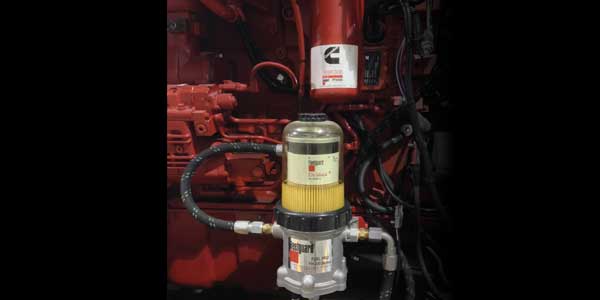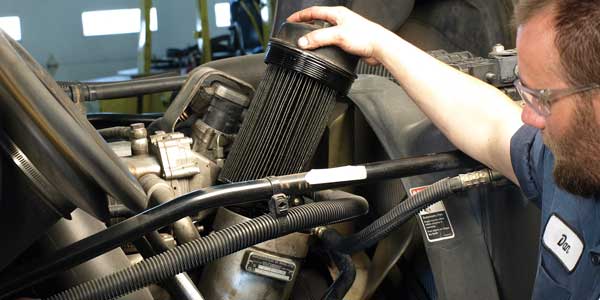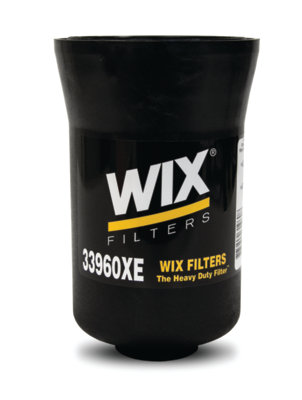From engines to transmissions, there has been a massive amount of innovation in recent years. As the new API category oils—CK-4 and FA-4—find their way into heavy-duty engines, fleets should continue to monitor the performance of their engines and adhere to the necessary oil analysis procedures. Just don’t forget about the filtration.
“With the new oils and the higher temperatures that engines are running today, they’re breaking down the oil differently than as in the past, which means you need a high-capacity filter per se for oxidation of the oil,” explained Donald Chilton, Wix Filters’ vice president of product management. “The engine manufacturers are recommending oil change intervals of 50,000 miles or more which means that filtration does have to deal with amplified contamination.”
Chilton went on to explain that the oil change interval bottom line comes down to the OEM’s recommendation. “That said, you’re going to continue to have older engines in fleets, and fleets are going to try to commonize oil purchases and maintenance practices,” Chilton said. “The FA-4 isn’t backward compatible in most cases, but the CK-4 oils are, and so fleets are going to going to have to continue to monitor the health of the engine.”
Veli Kalayci, director of engine liquid products for Donaldson Filtration, said that the biggest filter changes have come in the form of synthetic filter media formulations that deliver higher efficiency, lower pressure drop and higher capacity.
“It is essential that equipment owners collaborate with their oil and filter suppliers to analyze and draw meaningful conclusions from the data captured,” Kalayci said. “Working with a reputable filtration supplier and utilizing an oil analysis program is the best way a fleet can ensure they have the proper filtration in place to meet the demands of their fleet.”
 Want to take a close look at Wix Filters’ latest media technology? Click here to watch our video.
Want to take a close look at Wix Filters’ latest media technology? Click here to watch our video.
Coolant it down
Fifty-three percent—that’s the number of catastrophic, premature diesel engine failures directly related to improper cooling system maintenance techniques and habits, according to Wix Filters. Filtration plays a key role in coolant maintenance.
“Scale, leakage and erosion in the cooling system can be prevented by using the proper coolant filter,” explained Lauren Lewis, coolants and chemicals product development for Cummins Filtration. “The filter captures damaging contaminate that may contribute to water pump leakage, hot surface scaling and erosion driven by particulate. A complete preventive maintenance regimen consists of a quality, fully formulated coolant that meets all of the engine manufacturer’s requirements, and the use of superior coolant filtration to remove debris and contaminants that build up in coolants over time.”
Lewis went on to say that once an engine has a coolant filter, either as part of the initial engine or added later on, it is important to determine the service interval for the filter.
“A standard service interval is less than 500 hours or 25,000 miles,” she said. “Extended service interval [ESI] filters are recommended for use up to one year, 150,000 miles or 4,000 hours, whichever comes first, on engines with coolant systems up to 20 gallons.”
Coolant filters intended to maintain additive levels rely on supplemental coolant additive (SCA) and controlled rate of release into the system, Donaldson’s Kalayci noted. “It is important to regularly check the coolant concentration and track the depletion rate of additives,” he said, and pointed to Donaldson’s coolant system test kits, which offer a one-minute test to determine the chemical balance of the a cooling system. “While fleets and customers may have their own sampling practices set by the engine or vehicle manufacturer, if they are not available, a general guideline is to test the coolant twice a year.”
“Test kits will tell you exactly what the nitrate concentration is [within the coolant],” Wix’s Chilton said. “Effectively, you’re trying to maintain a certain amount of nitrate in the coolant. You basically have two options, and it depends on what the OEM offers, because you’ve got two different types of filters—a pre-charged filter–which has a charge of coolant booster in it, and an uncharged version.”
In addition to regular testing of the coolant, Kalayci recommended periodic draining and flushing because, while coolant filters capture large contaminants and release SCA into the system, sediment can accumulate in the coolant system and act as an insulator, preventing heat dissipation.
Shifting gears
“As much as 90% of transmission failures are caused by contamination in the system,” said Don Weston, global product manager of commercial vehicle and hydraulic with Cummins Filtration. “Like any engine-related filtration system, transmission fluid filtration is important for keeping debris such as metal wear and any possible contamination out of critical transmission components.”
Contamination control has always been an important factor in the heavy-duty transmission environment, Kalayci said. “Striking a balance between an appropriate level of contaminant removal and an acceptable service life between maintenance periods has long been the filtration designer’s goal.
“The growth in AMTs has led to an increased awareness of contamination control,” he continued. “As electro-hydraulic controls are more sensitive to finer contaminant, we are seeing the need for more precise filtration of transmission fluid. Finer clearances and tolerance directly translate to finer levels of filtration, which have fallen to levels as low as 10 micrometers. Furthermore, the operating environment of high temperatures and more aggressive fluid chemistry drives the requirement for more thermally and chemically inert filter materials.”
That said, Cummins Filtration’s Weston noted that many AMTs no longer require true filters due to design changes that have created much more efficient and long-lasting transmission offerings. “Instead, many of these automated manual transmissions use mesh screens for basic cleaning of the transmission fluid,” he explained. “These screens are not regularly serviced and may typically only be cleaned during top-end engine service events.”
Despite the growing popularity of AMTs, chances are that your fleet is still made up primarily of manual transmissions, and those still require careful maintenance to ensure their longevity.
“Harsh environments, severe operation, or extreme-duty cycles may require more frequent change intervals,” Cummins Filtration’s Weston said. “Because transmission fluid cools, lubricates, and transmits hydraulic power, it is critical to maintain adequate fluid levels in your system at all times. When the fluid level is too low, the converter, bushings, bearings and clutches do not receive an adequate supply of fluid. If fluid levels are too high, they can aerate and cause your transmission to shift erratically or overheat.”
Medium-duty, heavy application
When it comes to filters for Class 3 to 6 trucks, duty-cycles should be impacted by the type of use, operating environment and age of the vehicle rather than the size of the vehicle, said Scott Killips, chief executive officer of Hubb Filters, which offers 3- and 8-in. all-metal spin-on oil filters covering Class 1 through 6 vehicles.
“For example,” Killips continued, “frequency and amount of idling requires an oil and oil filter that facilitates high oil flow in order to better protect an engine operating at low RPMs for extended period. Police vehicles, EMC vehicles and vocational trucks all experience this need.”















